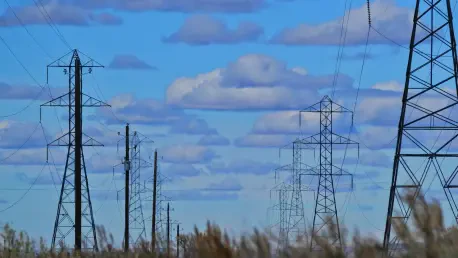A Pivotal Moment for Energy Infrastructure Investment
The U.S. energy sector stands at a critical juncture, grappling with an unprecedented surge in electricity demand that threatens to outpace the capacity of an aging grid. With data centers, artificial intelligence, and advanced manufacturing driving consumption to new heights, the U.S. Department of Energy (DOE) has stepped in with a landmark $1.6 billion loan guarantee to a subsidiary of American Electric Power (AEP), one of the nation’s largest electric utilities. Announced recently, this funding targets the reconductoring and rebuilding of approximately 5,000 miles of transmission lines across Indiana, Michigan, Ohio, Oklahoma, and West Virginia. This strategic move not only addresses immediate reliability concerns but also reshapes the market for transmission infrastructure investment. This analysis explores the underlying trends, market dynamics, and future projections surrounding this initiative, shedding light on its broader implications for utilities, investors, and consumers.
Market Trends and In-Depth Analysis
Surging Demand Reshapes Transmission Priorities
The energy market is witnessing a seismic shift as electricity demand escalates at a pace unseen in decades. AEP has committed to supporting 24 gigawatts of new demand by the end of the decade, a figure reflecting the intense pressure from tech-driven industries and electrification trends. Historically, transmission upgrades have lagged behind such growth, constrained by funding shortages and regulatory bottlenecks. The DOE’s intervention through the Energy Dominance Financing Program signals a market pivot toward large-scale, federally backed solutions. This trend suggests a growing reliance on public-private partnerships to bridge the infrastructure gap, with utilities like AEP positioned as key players in modernizing the grid to prevent outages and sustain industrial expansion.
Financial Mechanisms Driving Cost Efficiency
A notable aspect of this loan guarantee is its emphasis on affordability within the energy market. Under the program’s guidelines, utilities must pass financial benefits to consumers, and AEP projects savings of about $275 million in financing costs over the loan’s term. This cost reduction could stabilize or even lower rates for customers while freeing up capital for further grid enhancements. Additionally, innovative rate structures are emerging, ensuring that high-demand clients, such as data center operators, shoulder a fair share of infrastructure expenses. This shift in cost allocation is poised to redefine market expectations, encouraging a balance between investment scale and consumer impact, though equitable distribution of savings remains a challenge to monitor.
Economic Ripple Effects and Regional Market Growth
Beyond technical upgrades, the transmission rebuild is set to invigorate regional markets through substantial economic activity. The DOE and AEP anticipate the creation of approximately 1,100 construction jobs across the five affected states, with an initial focus on 100 miles of lines in Ohio and Oklahoma. This job growth is expected to stimulate local economies, particularly in the Midwest, where labor markets stand to benefit from direct employment and ancillary business opportunities. Market analysts note that such infrastructure projects often act as catalysts for broader investment, potentially attracting tech and manufacturing firms to regions with enhanced grid reliability. This trend underscores the intersection of energy policy with economic development, positioning transmission projects as engines of market vitality.
Policy and Regulatory Influences on Market Direction
The political landscape is another critical factor shaping the transmission infrastructure market. The current administration’s focus on American energy dominance, coupled with rigorous evaluation of federal spending, has introduced a layer of scrutiny to loan guarantees and grants. The approval of AEP’s funding under updated Loan Programs Office guidance reflects a market-friendly yet cautious approach to energy investments. This policy framework could influence future market behavior, as utilities may need to align projects with national priorities to secure similar support. While political shifts could alter funding availability over the next few years, the bipartisan need for a robust grid suggests sustained market interest in transmission modernization regardless of administrative changes.
Future Projections for Grid Investment Markets
Looking ahead, the market for energy infrastructure is likely to see accelerated growth as demand projections continue to climb. From this year through 2027, analysts expect a doubling of federal and private investments in grid upgrades, driven by technological advancements and the push for renewable integration. Smart grid technologies and digital monitoring systems are anticipated to play a larger role, potentially increasing the efficiency of projects like AEP’s. However, market risks persist, including supply chain disruptions for materials and labor shortages that could delay timelines. If unaddressed, these challenges might hinder the pace of modernization, underscoring the need for strategic planning and diversified funding sources to maintain market momentum in the transmission sector.
Reflecting on Market Shifts and Strategic Pathways
Looking back, the DOE’s $1.6 billion loan guarantee to AEP marked a defining moment in the energy infrastructure market, addressing urgent grid reliability needs while setting a precedent for federal involvement in utility projects. The initiative highlighted critical market trends, from soaring electricity demand to innovative cost-sharing models and regional economic boosts. It also revealed the intricate interplay of policy and market forces, shaping how utilities approach large-scale upgrades. For stakeholders, the path forward involves leveraging this momentum by advocating for streamlined regulatory processes to expedite future projects. Utilities are encouraged to explore partnerships with tech firms to integrate advanced grid solutions, while policymakers need to prioritize consistent funding mechanisms to mitigate market uncertainties. Ultimately, this development urges a collaborative approach to ensure that the energy market evolves in tandem with America’s growing needs, securing a resilient foundation for decades to come.









